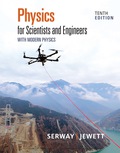
(a)
The potential energy of the system.
(a)
Answer to Problem 44CP
The potential energy of the system is
Explanation of Solution
Write the equation for potential energy.
Here,
Substitute
Here,
Write the equation for the potential energy of the system.
Here,
Conclusion:
Substitute equation (II) in equation (III) for each pair of energy.
Thus, the potential energy of the system is
(b)
The minimum kinetic energy of the two electrons.
(b)
Answer to Problem 44CP
The minimum kinetic energy of the two electrons is
Explanation of Solution
Let the minimum energy of the electron be
Here,
Substitute
Write the equation for the minimum kinetic energy of the two electrons.
Here,
Conclusion:
Substitute equation (V) in equation (VI) to find
Thus, the minimum kinetic energy of the two electrons is
(c)
The value of
(c)
Answer to Problem 44CP
The value of
Explanation of Solution
Write the equation for the total energy.
Here,
Substitute equation (IV) and (VII) in the above equation to find
Write the condition for the energy to be minimum.
Conclusion:
Substitute equation (VIII) in the above equation to find
Rearrange the above equation for
Substitute
Thus, the value of
(d)
Compare the value of
(d)
Answer to Problem 44CP
The lithium inter-atomic spacing is in the same order of magnitude as the interatomic spacing of
Explanation of Solution
Write the equation for volume.
Here,
Write the equation for density.
Here,
Substitute equation (X) in the above equation and rearrange to find
Conclusion:
Substitute
The lithium interatomic spacing is 5.59 times larger than
Thus, the lithium interatomic spacing is in the same order of magnitude as the interatomic spacing
Want to see more full solutions like this?
Chapter 40 Solutions
Physics for Scientists and Engineers with Modern Physics
- When a dilute gas expands quasi-statically from 0.50 to 4.0 L, it does 250 J of work. Assuming that the gas temperature remains constant at 300 K. What is the change in the internal energy of the gas? How much heat is absorbed by the gas in this process?arrow_forwardA high-speed lifting mechanism supports an 881 kg object with a steel cable that is 22.0 m long and 4.00 cm^2 in cross-sectional area. Young's modulus for steel is 20.0 ⋅10^10 Pa. Determine the elongation of the cable.arrow_forwardNamor, from Wakanda Forever, sits on a throne at the bottom of the ocean in a city called Talocan (and Atlantis in the comics). Assuming he, including his gold headdress, has a density of 1085 kg/m3 and that Namor is surrounded by salt water with a density of 1027 kg/m3, what is Namor’s normal force while sitting underwater? Take Namor’s mass as 285. kg and solve as if he has a uniform density.arrow_forward
- To get there they need to travel through an area of salt-water, which seems to also be a magical portal, before arriving in a dry area. Judging by the time Maui and Moana spend falling through the water, it seems they dive 3440. ft deep. Assume the portal is non-magical salt-water, with a density of 1027 kg/m^3. Given that the air pressure above the portal is 1.013 ⋅10^5 Pa, what is the pressure when they are 3440. ft deep? 1 m = 3.28 ft. Moana would have a surface area of 1.30 m2. How much force would be acting on her at the bottom of this portal?arrow_forwardA plank 2.00 cm thick and 15.7 cm wide is firmly attached to the railing of a ship by clamps so that the rest of the board extends 2.00 m horizontally over the sea below. A man of mass 92.9 kg is forced to stand on the very end. If the end of the board drops by 5.97 cm because of the man's weight, find the shear modulus of the wood.arrow_forwardwhen considering particle B (4,1) distances in relation to P (-4, 5), why are the y coordinates being used gto resolve the distance along the x-axis and vice-versa?arrow_forward
- A 198 kg load is hung on a wire of length of 3.58 m, cross-sectional area 2.00⋅ 10-5 m2, and Young's modulus 8.00⋅10^10 Pa. What is its increase in length?arrow_forwardI. Pushing on a File Cabinet Bob has been asked to push a heavy file cabinet down the hall to another office. It's not on rollers, so there is a lot of friction. At time t = 0 seconds, he starts pushing it from rest with increasing force until it starts to move at t = 2 seconds. He pushes the file cabinet down the hall with varying amounts of force. The velocity versus time graph of the cabinet is shown below. A. On the graphs provided below, 1. draw the net force vs. time that would produce this velocity graph; 2. draw the friction force vs. time for this motion; 3. draw the applied force (Fon Cabinet by Bob) VS. time for this motion (the first two seconds of this graph have been drawn for you). Velocity (m/s) Applied Force (N) Friction Force (N) Net Force (N) A -m B -U time (s) D time (s) time (s) time (s)arrow_forwardanswer itarrow_forward
 Physics for Scientists and Engineers with Modern ...PhysicsISBN:9781337553292Author:Raymond A. Serway, John W. JewettPublisher:Cengage Learning
Physics for Scientists and Engineers with Modern ...PhysicsISBN:9781337553292Author:Raymond A. Serway, John W. JewettPublisher:Cengage Learning Modern PhysicsPhysicsISBN:9781111794378Author:Raymond A. Serway, Clement J. Moses, Curt A. MoyerPublisher:Cengage Learning
Modern PhysicsPhysicsISBN:9781111794378Author:Raymond A. Serway, Clement J. Moses, Curt A. MoyerPublisher:Cengage Learning University Physics Volume 3PhysicsISBN:9781938168185Author:William Moebs, Jeff SannyPublisher:OpenStax
University Physics Volume 3PhysicsISBN:9781938168185Author:William Moebs, Jeff SannyPublisher:OpenStax Principles of Physics: A Calculus-Based TextPhysicsISBN:9781133104261Author:Raymond A. Serway, John W. JewettPublisher:Cengage Learning
Principles of Physics: A Calculus-Based TextPhysicsISBN:9781133104261Author:Raymond A. Serway, John W. JewettPublisher:Cengage Learning Classical Dynamics of Particles and SystemsPhysicsISBN:9780534408961Author:Stephen T. Thornton, Jerry B. MarionPublisher:Cengage Learning
Classical Dynamics of Particles and SystemsPhysicsISBN:9780534408961Author:Stephen T. Thornton, Jerry B. MarionPublisher:Cengage Learning Glencoe Physics: Principles and Problems, Student...PhysicsISBN:9780078807213Author:Paul W. ZitzewitzPublisher:Glencoe/McGraw-Hill
Glencoe Physics: Principles and Problems, Student...PhysicsISBN:9780078807213Author:Paul W. ZitzewitzPublisher:Glencoe/McGraw-Hill





